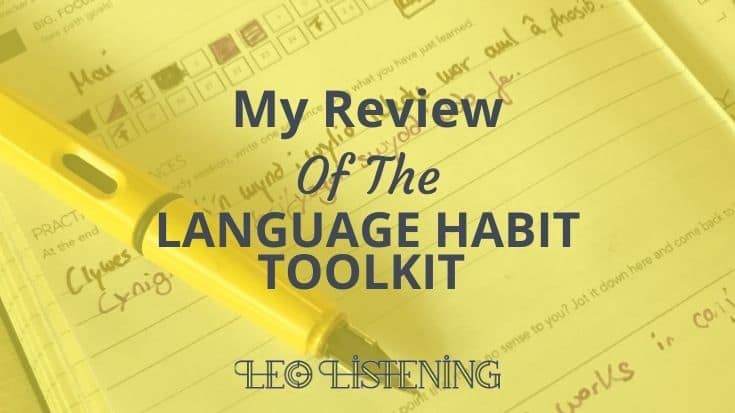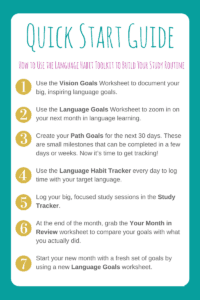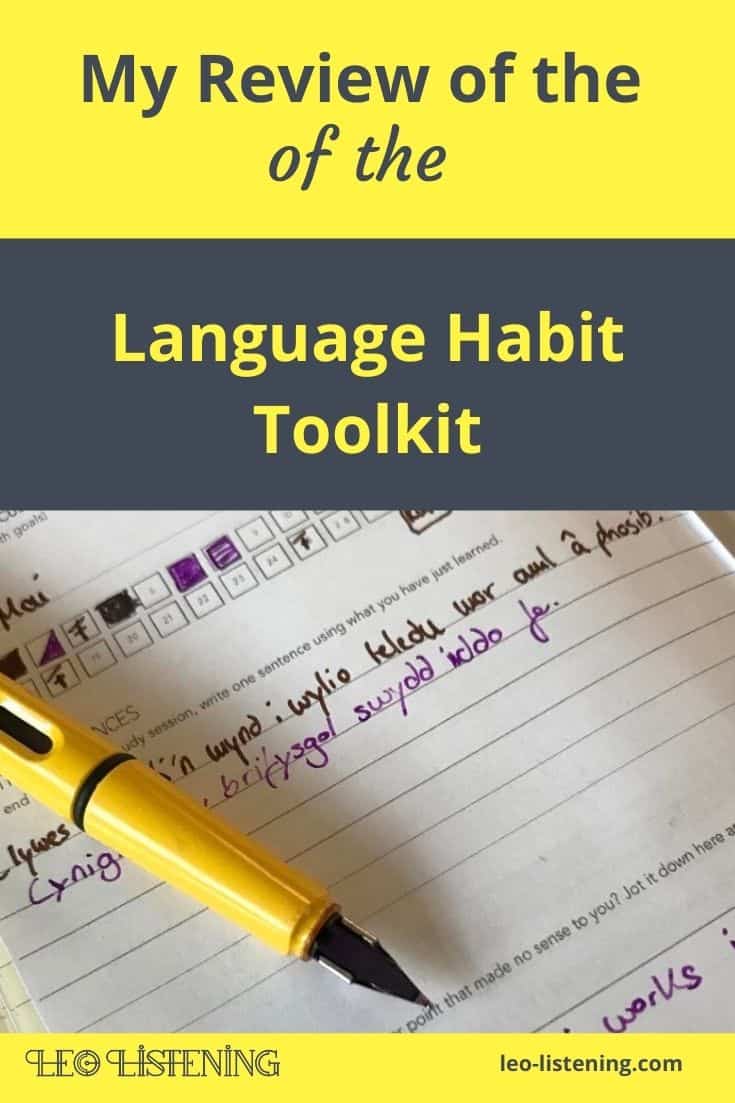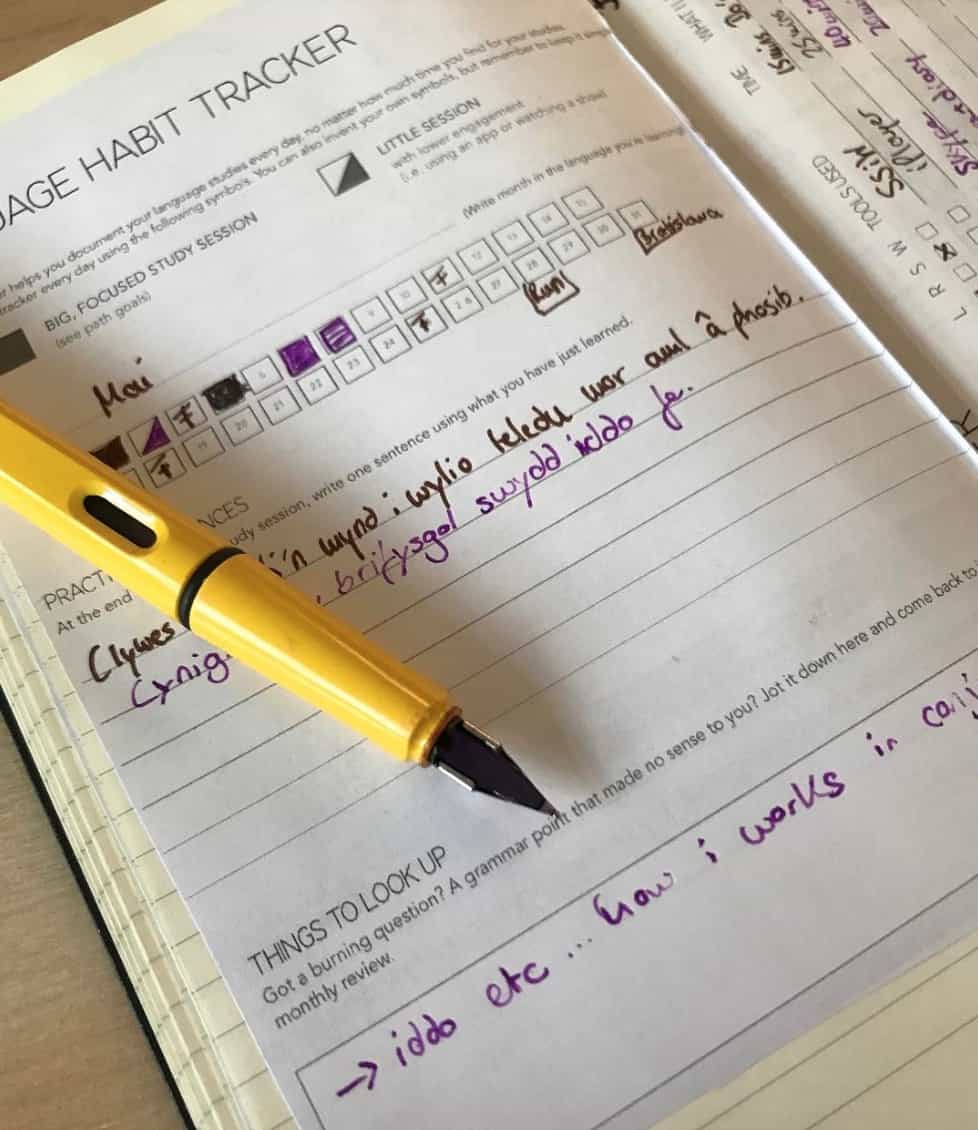My Review Of The Language Habit Toolkit

“Habits are the invisible architecture of everyday life.” Gretchen Rubin
The internet houses a bizillion habit quotes (just Google the expression “habit quotes” and you’ll see what I mean). I chose that one because:
- It’s poetic
- I like architecture
- It’s true
Then I read through the handbook part of the Language Habit Toolkit that I’m reviewing in this post. At the end, it’s creator, Kerstin, recommends Gretchen Rubin’s book, Better than Before which is all about changing your life through building habits.
Great minds think alike eh?
I’ve become habit obsessed over the last few months. I was in the Real Life English Facebook group one day, when Justin Murray posted this article on goals vs systems, by James Clear.
I found myself nodding along with it. Then I downloaded James’ guide, Transform Your Habits.
Ready for another killer quote?
“What you repeatedly do (i.e. what you spend time thinking about and doing each day) ultimately forms the person you are, the things you believe, and the personality that you portray.”
After reading that guide, lots of things started to click and fall into place for me. So:
- I created and tracked my own habits
- I devoured any blog post or book on habit building
- I got into bullet journaling as a way of completing and tracking daily habits
The ideas in that guide and elsewhere led me to write this post for my colleague Kirsty on building the listening habit.
So, when Kerstin told me that she had created the Language Habit Toolkit, I jumped at the chance to get my copy and review it as part of language habit blog tour along with some fellow language bloggers.
Kerstin, in case you don’t know her, runs a blog called Fluent, is a language tutor and helps teachers make the move online. She’s German but sounds like a Brit, speaks 7 or 8 languages and is learning Welsh.
As you can imagine, Kerstin knows her stuff when it comes to building a language habit.
What IS the Language Habit Toolkit then?
It’s not an ebook, but it’s not a course either. It’s a system for tracking your language learning habits so you can achieve your goals.
When you first download it, you get various bits and pieces. The easiest thing to do is open the quick start guide to get going straight away.

Get Dreamy
How often do you give yourself permission to dream about your language learning goals?
That’s exactly what you do in the next step: the vision goals worksheet. Kerstin has designed it so you get all dreamy about your language plans by creating vision goals.
Your vision goals are your crazy dream for your language. You don’t have to achieve these goals, but they maintain your motivation and inspiration. Even when it gets tough.
You dig into your vision goals by answering questions like “Which blogs, shows and podcasts inspire you?” I love that one, as you can imagine!

The Goldilocks Period
In the language goals worksheet, you focus on what you want to do in the next month by setting your 30 day goals.
I class this as a “Goldilocks” time period: not too long, not too short, but just right. I have a particular affinity with that fairy tale as I love porridge and used to have blonde hair.
You then fill out your path goals for each language skill (reading, writing, listening, speaking). I know understanding spoken English is your priority. But you can cover the 4 skills while making listening your main focus:
Listening
- Listen to your favourite podcast and work on it in the usual way.
Speaking
- After you’ve finished listening, record yourself summarising the topic of the podcast, as if you were chatting to a friend about it. Or better yet, find your podcast partner and meet up online or in person to chat about the topics in the episode.
Reading
- Read the show notes that come with the podcast either before or after listening.
Writing
- Leave a review of the podcast. Share what you enjoyed most about the show in the comments. Ask the host a question – maybe you’ll give them inspiration for the next episode.
So your path goals could look like this:
- Listen to an episode of (insert the name of your favourite podcast) weekly
- Speak for at least 1 minute about each episode
- Understand 70% of the show notes
- Leave a review of the podcast
Path goals build on each other every month. So you don’t need to know all the path goals for the year ahead.
You take what you achieved in 30 days and then add to it, according to your progress. Your path goals are steps to your destination. That’s why Kerstin talks about trusting the process, not the outcome.
The Immense Satisfaction Of Filling Stuff Out

Are you a visual learner?
Do you like seeing your progress?
I love writing to-do lists. Sometimes, I even add a task that I hadn’t written, just to get the satisfaction of ticking it off.
So the study tracker, despite its name, got me really excited.
In the study tracker you get into the nitty-gritty of habits. Whenever you do a longer study session, you check off what you did, track the time spent, the tools used and note what you learnt.
Imagine how guilty you’d feel if you left a big gap. And how accomplished you’d feel after filling it out.
The language habit tracker (that you saw above) is a little less detailed. It’s very bullet-journal inspired, with squares to fill out each day to show that you completed either a big or little study session.
You use this space to write down any sentences from your study sessions and to note any questions you didn’t have time to check, like a grammar question.
This leads us on nicely to the next bit of the toolkit.
Secrets Of Success From One Of My Best Students
I’ve built space for reflection and review into my teaching.
One of my students started doing this quite spontaneously, reflecting on what he found hard to catch in dictations we were working on.
So I created worksheets with space for review and reflection in my programmes. That lets my students notice what they’re getting better at (yes, you need to celebrate your wins) and what they need to improve. I get some great insights from them whenever I do this.
When you’re learning a language on your own, the review process is even more important. In Kerstin’s month in review worksheet, you review
- Your path goals (and update or discard them)
- What went well and not so well
- Your tracker, including the number of study sessions and things to look up
Language Learning’s Most Controversial Word
Kerstin includes a video sharing her tips on goal setting. The highlight for me was when she said that you’re never really done with a language – you’re in it for life. That’s why you need to put in place habits.
Kerstin’s take on goal-setting is flexible and about you. Your goals are a snapshot of where you’re at now, not something you have to stick to forever. More importantly, your goals are for you – you don’t have to copy goals from others, unless you want to.
She also addresses one of the most controversial words in language learning: “fluency”.
Why controversial?
Well, what does it mean?
Different people interpret “fluency” in different ways. I would say I have native-like French in speaking and listening. For me, that’s higher than “fluency’. For others, “fluency” and native-like or even native are the same thing. For some people, a B1 level in speaking means fluency.
I Challenge You Not To Be Inspired!
The handbook that comes with the kit is inspiring. It’s all about becoming better and never quitting.
Kerstin walks her talk here. Take her relationship with French. She considered giving up that language at one point. But she decided to commit to it and persist in learning it, no matter what. That’s what made her a French speaker – not some special talent, or genes or whatever.
I love that Kerstin encourages us to be realistic and is honest about her own commitments. She spends around 20 minutes a day learning languages. Proof that you don’t have to lock yourself away for 6 hours every day to move forward in your language learning.
Language Habit Toolkit Review: Final Thoughts

The Language Habit Toolkit is a great investment for independent learners of any language, including English. Once you’ve bought a copy, you can use it for life to keep up your language habit.
As I’ve shown you, you can use it to track your listening habit. And adapt your listening work to include a focus on the other core skills.
The only downsides are:
I would have liked to see more examples of path goals in the handbook to help me create them.
The kit assumes you know which resources to use for your language. I guess that’s a bit easier in English where the Internet IS in English. But if I were getting back into Spanish or starting Japanese (which I’m considering!), I’d need a bit of help to find the right resources.
If you love the sound of tracking your language learning progress, check out Kerstin’s Language Habit Toolkit.
Thanks for the post about building habits! I’m going to check out the book you mentioned Better than before. I really want to apply better habits to my Chinese studying!
I still need to check out the book actually – it’s on my reading list. Make sure you check out the Language Habit Toolkit too – I think it would be the most practical way to get back into learning Chinese.
Really useful article. A must read for every English learner. Learning is all about building new habits.
Couldn’t agree more. Thanks for sharing your thoughts.